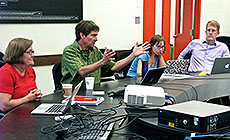SAC fosters labwide communication, newly established EAC follows suit
 |
| Members of the Scientific Advisory Council, pictured here, and members of the Engineering Advisory Council advise and inform the laboratory director of progress in their respective communities. Photo: Hanae Armitage
|
A year ago in May, former Fermilab Director Pier Oddone established the Scientist Advisory Council — a forum dedicated to scientific advice and communication at Fermilab. A total of 15 members, including co-chairs Robert Tschirhart and Regina Rameika, Fermilab Director Nigel Lockyer and a handful of senior managers, now come together every week to review the lab's current science-related issues.
SAC meetings are group discussions that act as a sounding board and a source of communication for scientists across the lab. The meetings constructively lace together advice, ideas and feedback to provide united guidance for the lab's scientific community.
"It's not just information coming to the director," Tschirhart said. "Each member is a representative of a body, and they take information back to their groups and relay what was talked about."
With the heightened connectivity spurred by SAC, Lockyer and Deputy Head of the Accelerator Division Paul Czarapata applied similar logic to Fermilab's engineering community, creating the Engineering Advisory Council.
It was in May that the 12 members of the EAC, led by co-chairs Czarapata and Technical Division's Lidija Kokoska, held its first meeting. Even as a new council, the EAC is eager to make a difference, and meetings provide an energetic platform that foster engineering collaboration and logistical project guidance.
Although the EAC and SAC are concerned with different aspects of Fermilab, the common ground lies in the councils' approach — both are forums that facilitate the free flow of ideas and perspectives across the lab. Fermilab's Employee Advisory Group, which started in 2009, fulfills a similar role for for all laboratory employees, including nontechnical staff.
"Nigel is very supportive of communication. He's got a theme: One lab, open communication," Rameika said. "The goal is to know what's going on and why. Having these advisory councils is his way of getting feedback and information from all of us."
The key is diversity. Scientists and engineers of varied backgrounds come from all over the lab to create the councils. Each person offers a different view on how a process may or may not work, making heterogeneity the councils' most effective tool.
"Very often when I talk to friends outside of the laboratory, they say 'Oh yeah, that's the place with all the physicists,'" Czarapata said. "But of course it's not only the place with all the physicists. It's a place where everybody from the administrative side and all the way through the engineers and programmers come together to really make this lab work."
—Hanae Armitage
|